Memes aren’t just internet humor—they’re one of the most viral communication formats online. According to research from YPulse, 75% of people aged 13–36 share memes regularly, and meme-related engagement rates are up to 60% higher than traditional ad visuals on social media. The key? They feel native to the platform and don’t look like ads.
For marketers, memes offer a shortcut to cultural relevance. When done right, they blend entertainment with brand messaging and can drive awareness faster than polished creative.
The Risk: When Memes Backfire
However, memes can hurt your brand if used without care. Here’s why:
1. Tone mismatch
If your brand has a professional or premium image, using low-quality meme humor can confuse your audience. Consistency matters—people trust brands that sound the same across all channels.
2. Outdated or misused formats
Using an old or overused meme makes your brand seem out of touch. It signals you’re chasing trends, not leading them.
3. Misinterpreted humor
Cultural nuances can backfire. A meme that seems harmless in one region can be offensive in another. Always review content for context and cultural sensitivity.
How to Use Meme Ads Without Losing Credibility
1. Stick to relatable insights, not random jokes
Great meme ads work when the humor ties directly to your audience’s real pain points. For example, a digital marketer laughing about ad fatigue connects better than a generic pop-culture meme.
2. Keep visuals clean and brand-consistent
Even when using memes, maintain your brand’s visual identity—color palette, logo placement, and tone. Clean design helps the humor feel intentional, not sloppy.
3. Test meme formats before scaling
Run small A/B tests with meme creatives. Compare engagement rates, CTR, and reactions versus your standard visuals. Some audiences might love them; others might not.
4. Use data-driven timing
Memes move fast. Monitor engagement windows—most memes peak within 3 to 5 days. If you jump in too late, you’ll look like you’re following, not leading.
5. Balance humor with value
Make sure the message still aligns with your ad goal. Even if a meme gets attention, it must still lead viewers to act—click, sign up, or buy.
The Winning Formula: Humor + Context + Consistency
The best meme ads combine cultural awareness with strategic intent. They feel spontaneous but are backed by testing and audience understanding. Your audience should laugh and remember your brand—not just the joke.
Final Thoughts
Meme-style ads are powerful when used purposefully. They break the monotony of traditional advertising and can humanize your brand. But credibility is fragile—so every meme should fit your brand voice, audience mindset, and campaign goals.
Suggested Reading
If you found this article helpful, you might also like:

